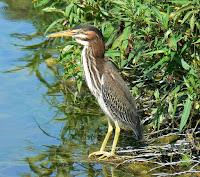GREEN HERON
GREEN HERON (Butorides virescens) – (See images below)
DESCRIPTION: The Green Heron adults have dark green cap, back and wings, a reddish brown neck with white stripes along the throat and breast. Tail is short and dark green. Under parts are grey. Eyes and leggs are yellow. Bill is black on top, yellow under, longer than the head and sharp-ended. There is a yellow line between bill base and eye. Female is smaller with duller colors. Juveniles also have duller colors and more whitish stripes on the breast. Bird length is about 45 cm (17 inches). There are several subspecies.
VOICE: https://www.xeno-canto.org/species/Butorides-virescens
NAME: ‘Heron’ would mean ‘to creak or screech’ (in reference to the bird’s call). Latin genus name ‘Butorides’ stems from ‘butio’ (bittern), and ‘eidos’ (resembling). Latin species name ‘virescens’ means ‘becoming green’.
HABITAT: Small freshwater wetlands such as marshes and ponds.
DIET: Fish for the most part, also crustaceans, insects, small reptiles and amphibians.
NESTING: Usually nests in lone pairs or small groups. Nest is a stick-made platform built in a shrub or a tree generally near water. Between three and five light green eggs are laid, incubated by both parents, who also both feed the chicks.
DISTRIBUTION: Breeding range covers eastern half of the USA and southeast edge of Canada. There is also a small breeding population along the north half of the USA west coast, as well as the south west coast of British Columbia. Wintering range includes south central USA and Mexico. Year-round range covers southeast coast of USA, south half of USA west coast, the remainder of Mexico, Central America and the Caribbean. Some individuals have been reported on Hawaii. (see note below on Bird Vagrancy).
Distribution Map: https://en.wikipedia.org/wiki/Green_heron#/media/File:Butorides_virescens.svg
ON PEI: Does not breed on Prince Edward Island, sightings listed as accidental (summer and fall) or occasional (spring).
CONSERVATION: Population has steadily declined over last few decades but still not considered globally at risk. One threat might be habitat loss from wetland drainage.
NOTES: This heron species is known to often use tools such as bread crusts, etc., to lure prey.
Vagrancy: In biology this means an animal going way outside its normal range. For birds, this can happen when there are storms and they get blown off course. On other times, the bird simply wanders in a different direction than usual. Here’s an article about vagrancy in birds.
SIMILAR SPECIES: Least Bittern, American Bittern, Black-crowned Night Heron, Yellow-crowned Night Heron
REFERENCES: https://en.wikipedia.org/wiki/Green_heron
https://www.mba-aom.ca/jsp/toc.jsp (Maritimes Breeding Bird Atlas)
https://www.audubon.org/field-guide/bird/green-heron
https://www.allaboutbirds.org/guide/Green_Heron/id
https://nature.mdc.mo.gov/discover-nature/field-guide/green-heron (Missouri Department of Conservation)
http://fieldguide.mt.gov/speciesDetail.aspx?elcode=ABNGA08010 (Montana Field Guide)
https://animaldiversity.org/accounts/Butorides_virescens/ (University of Michigan)
https://txtbba.tamu.edu/species-accounts/green-heron/ (Texas Breeding Bird Atlas)
https://birdatlas.mb.ca/accounts/speciesaccount.jsp?sp=GRHE&lang=en (Manitoba Breeding Bird Atlas)
DESCRIPTION: The Green Heron adults have dark green cap, back and wings, a reddish brown neck with white stripes along the throat and breast. Tail is short and dark green. Under parts are grey. Eyes and leggs are yellow. Bill is black on top, yellow under, longer than the head and sharp-ended. There is a yellow line between bill base and eye. Female is smaller with duller colors. Juveniles also have duller colors and more whitish stripes on the breast. Bird length is about 45 cm (17 inches). There are several subspecies.
VOICE: https://www.xeno-canto.org/species/Butorides-virescens
NAME: ‘Heron’ would mean ‘to creak or screech’ (in reference to the bird’s call). Latin genus name ‘Butorides’ stems from ‘butio’ (bittern), and ‘eidos’ (resembling). Latin species name ‘virescens’ means ‘becoming green’.
HABITAT: Small freshwater wetlands such as marshes and ponds.
DIET: Fish for the most part, also crustaceans, insects, small reptiles and amphibians.
NESTING: Usually nests in lone pairs or small groups. Nest is a stick-made platform built in a shrub or a tree generally near water. Between three and five light green eggs are laid, incubated by both parents, who also both feed the chicks.
DISTRIBUTION: Breeding range covers eastern half of the USA and southeast edge of Canada. There is also a small breeding population along the north half of the USA west coast, as well as the south west coast of British Columbia. Wintering range includes south central USA and Mexico. Year-round range covers southeast coast of USA, south half of USA west coast, the remainder of Mexico, Central America and the Caribbean. Some individuals have been reported on Hawaii. (see note below on Bird Vagrancy).
Distribution Map: https://en.wikipedia.org/wiki/Green_heron#/media/File:Butorides_virescens.svg
ON PEI: Does not breed on Prince Edward Island, sightings listed as accidental (summer and fall) or occasional (spring).
CONSERVATION: Population has steadily declined over last few decades but still not considered globally at risk. One threat might be habitat loss from wetland drainage.
NOTES: This heron species is known to often use tools such as bread crusts, etc., to lure prey.
Vagrancy: In biology this means an animal going way outside its normal range. For birds, this can happen when there are storms and they get blown off course. On other times, the bird simply wanders in a different direction than usual. Here’s an article about vagrancy in birds.
SIMILAR SPECIES: Least Bittern, American Bittern, Black-crowned Night Heron, Yellow-crowned Night Heron
REFERENCES: https://en.wikipedia.org/wiki/Green_heron
https://www.mba-aom.ca/jsp/toc.jsp (Maritimes Breeding Bird Atlas)
https://www.audubon.org/field-guide/bird/green-heron
https://www.allaboutbirds.org/guide/Green_Heron/id
https://nature.mdc.mo.gov/discover-nature/field-guide/green-heron (Missouri Department of Conservation)
http://fieldguide.mt.gov/speciesDetail.aspx?elcode=ABNGA08010 (Montana Field Guide)
https://animaldiversity.org/accounts/Butorides_virescens/ (University of Michigan)
https://txtbba.tamu.edu/species-accounts/green-heron/ (Texas Breeding Bird Atlas)
https://birdatlas.mb.ca/accounts/speciesaccount.jsp?sp=GRHE&lang=en (Manitoba Breeding Bird Atlas)
 |
| Green heron, photo by Basar |
 |
| Green heron 'maculata', Guadeloupe by Paleixmart, May 2007 |
 |
| Green heron nestlings, Isla Damas, Costa Rica - by Agathman |
 |
| Green heron subadult, by MONGO |
 |
| Green heron, breeding plumage FL, by Peter Wallack |